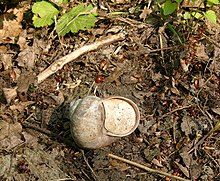Alb snail
As Albschnecke are snails called, according to the guidelines of the IG Albschneck on the Swabian Alb reared and consumption are marketed.
history
The climatic conditions of the Swabian Alb, a calcareous low mountain range, and the characteristic food plants in this area are suitable for producing Roman snails with a particularly good, nutty taste. Snails are rich in protein and minerals, at the same time free of cholesterol and were popular as a fasting food in Catholic regions . The snails collected from nature were kept in specially set up enclosures, the snail gardens, in order to fatten them. Traditionally, they were then harvested as so-called flat snails. Before hibernation, Roman snails eat some fatty tissue and, after the gastrointestinal tract has been emptied, close the opening of the snail shell with a lime cover.
In the 18th and 19th centuries, hamlets in the Großer Lautertal in particular were considered to be the stronghold of the snail trade. Theodor Engel wrote in a travel guide about the Swabian Alb in 1900: " From the realm of the molluscs it should be mentioned that the well-known Roman snail (Helix pomatia L.) occurs on the Alb in specimens that exceed all others in the country in size and thick-shelledness The animal is still bred here and there in its own "snail gardens", which we have only ever met on the Alb until now. "
IG Albschneck
Inspired by Slow Food , an international organization that has set itself the goal of preserving traditional food and production techniques, the IG Albschneck, in which producers, restaurateurs and tourism experts have come together, was founded in 2004 to deal with the traditional production and marketing of To revive Roman snails in the Swabian Alb. In order to be marketed under the trademark "Albschneck", the snails must have been reared according to IG Albschneck guidelines. This means that the Roman snails were raised extensively within the Swabian Alb natural area for at least one year and were mainly fed with wild plants. The snails may only be marketed as so-called lid snails, i.e. during the winter dormancy.
Slow Food added the Alb snail to its Ark of Taste in February 2005 .
Individual evidence
- ↑ a b c d e https://www.slowfood.de/biodiversitaet/die_arche_passagiere/albschnecke/ accessed May 31, 2015
- ↑ a b Studies on the keeping of Roman snails ( Memento from July 4, 2012 in the Internet Archive ) Master's thesis Simon Frädrich, pp. 14–16, accessed on May 31, 2015
- ↑ Theodor Engel: Our Swabian Alb. Pastor Dr. Angel. Ulm 1900. p. 20., quoted from - ( Memento of the original of July 10, 2015 in the Internet Archive ) Info: The archive link was inserted automatically and has not yet been checked. Please check the original and archive link according to the instructions and then remove this notice. accessed on May 31, 2015
